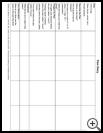
Neck Pain
What is neck pain?
Neck pain is often a temporary problem caused by a strain. However, sometimes neck pain can signal a more serious problem. If your child's neck hurts, he or she may:
- Complain of pain in the back of the neck or upper back. (pain in the front of the neck usually is due to a sore throat or swollen lymph node.)
- Cock (tilt) his head to one side
- Have neck muscles that are tender to touch
What causes neck pain?
Neck pain is usually caused by strained neck muscles. The most common modern cause is working with the head down in a flexed position. Such head tilting occurs with texting or looking at smart devices.
Other triggers are sleeping in an awkward position, carrying a backpack improperly, reading in bed, sitting for too long at the computer, playing a sport, or other similar activities.
A stiff neck (your child can't bend forward and touch his chin to the chest) can be an early symptom of meningitis. In this case your child usually will also have a fever. Any child suspected of having meningitis needs to be seen immediately.
Serious spinal cord injury can result from diving injuries, trampoline injuries, or other accidents involving the neck. Children who have suffered such an accident should not be moved until a neck brace or spine board has been applied by a rescue squad.
How long will it last?
A strained neck isn't serious and usually lasts 1 to 2 weeks.
How can I take care of my child?
- Pain-relief medicines
Give acetaminophen (Tylenol) or ibuprofen (Advil) until your child has gone 24 hours without any pain. This is the most important part of treatment because neck pain causes muscle spasm and thus more pain, and these medicines can stop this cycle.
- Cold
During the first 2 days, massage the sore muscles with a cold pack or ice pack for 20 minutes 4 times per day. To avoid frostbite, do not leave the cold packs on too long.
- Heat
After 2 days, put a heating pad, hot water bottle, or hot shower spray on the most painful area for 20 minutes to relieve muscle spasm. Do this whenever the pain flares up.
- Sleeping position
Your child may prefer to wear a foam neck collar at night. This will keep the head from moving too much during sleep. (You can buy a foam collar at a pharmacy.)
- Exercises
Your child should avoid any neck strengthening exercises until he is completely well. However, stretching exercises may be helpful, as long as they don’t increase the pain.
How can neck pain be prevented?
If your child has had more than one neck ache, usually he has an activity or habit that overstresses the neck muscles. Long periods of looking down is the most common one. Seen mainly with texting or using other mobile devices. Teens need to take breaks or sometimes hold the device at eye level.
Other activities to avoid are working with the neck turned or bent backward, carrying heavy objects on the head, carrying heavy objects with one arm (instead of both arms), standing on the head, contact sports, or even friendly wrestling.
Also, improve the tone of the neck muscles with 2 or 3 minutes of neck stretching exercises per day. Helpful stretching exercises are touching the chin to each shoulder, trying to touch the ear to the shoulder without raising the shoulder, and moving the head forward and backward. Don't apply any resistance (counterforce) during the stretching exercises.
When should I call my child's healthcare provider?
Call IMMEDIATELY if:
- The pain becomes severe AND persists more than 2 hours after taking a pain medicine.
- Numbness or tingling occurs in the arms or upper back.
- Your child has a fever over 100°F (37.8°C).
- Your child also has a headache.
- Your child starts acting very sick.
Call during office hours if:
- The pain is unexplained (not from muscle strain) AND persists more than 24 hours even though your child has taken pain medicine.
- The pain is no better after 3 days of treatment.
- The pain is still present after 2 weeks.
- You have other concerns or questions.
Last modified: 2016-07-13
Last reviewed: 2017-06-05

